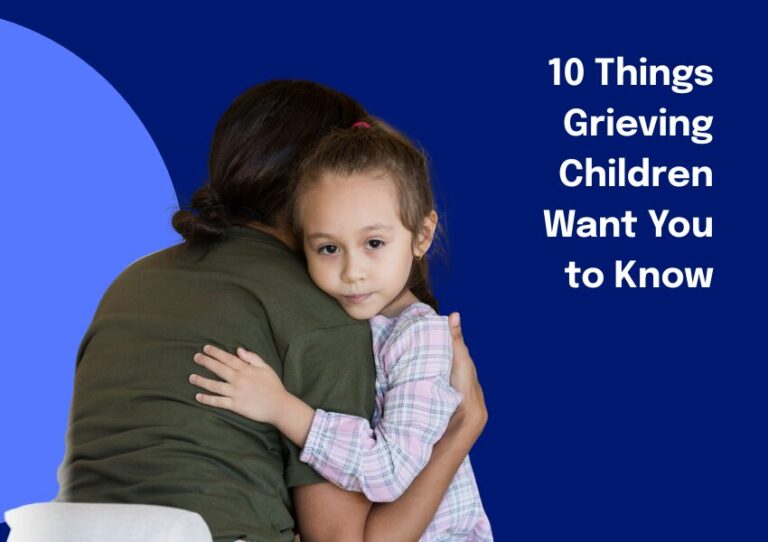Explaining Homicide to Children
 When an act of violence ends in death survivors will also experience thoughts and feelings related to the circumstances of the death along with the full range of natural grief responses. Each person will grieve in their own unique way. A child’s mourning process will be influenced by their chronological age, their previous experience with death and their relationship to the person who died.
When an act of violence ends in death survivors will also experience thoughts and feelings related to the circumstances of the death along with the full range of natural grief responses. Each person will grieve in their own unique way. A child’s mourning process will be influenced by their chronological age, their previous experience with death and their relationship to the person who died.
A homicide may shatter the griever’s assumptions about the world as a safe, predictable place. Children will struggle to understand how something so unimaginable could have happened. They may be filled with fear and dread that they themselves or another family member might also be killed. They may encounter environmental changes including legal and financial hardships, withdrawal of social support, and/or separation from other family members and friends.
Whether you are a parent, caregiver or therapist, a death due to homicide is considered one of the most challenging types of death to talk about with children. The immediate aftermath of the death is a time of confusion and intense emotion for everyone involved. Adults may wonder whether they should tell their child how their loved one died. While it may be well-intentioned to choose not to tell the truth about the death, an honest explanation is essential to the child’s grieving and healing process.
Clear, age-appropriate explanations are crucial as children address the first task of mourning and accepting the reality of the death, as identified by the leading authority on grief, Dr. J. William Worden (Grief Counseling & Grief Therapy, 2009). Adults often wonder what is “age-appropriate” and therefore avoid the truth entirely. Very young children will also struggle to understand what death is and will need language to use that feels manageable to them when discussing what happened to their loved one.
Offer simple, direct information and then ask your child if they have any questions. In general, if the child is old enough to ask the questions then they are old enough to hear the answers. The following examples are helpful tools for explaining homicide to children and helping them talk about what happened:
For young children after a homicide:
“A sad, terrible thing has happened that is not your fault. Daddy was walking to his car and a bad man shot him with a gun. Daddy was hurt very badly and he died.” Monitor and respond to any questions the child asks.
Alternatively after a homicide:
“Your mom stopped at the grocery store. While she was in line to check out a bad person with a gun tried to rob the store. The man started shooting and one of the bullets hit mommy. She was hurt so badly that she died.”
Prior to the mourning ritual or returning to school:
If it appears to be too difficult for the child to talk about the circumstances of the death they can be taught to use the word “homicide.” Children may prefer to avoid the topic or will answer in what ever way feels comfortable. For example a 13 year old boy was asked by his teammates“will your dad be at the game tonight?” Rather than say “no because my dad died” he chose to respond “no, he can’t be there.” It is empowering to discuss different options with your child in preparation for the inevitable questions from curious peers.
Explaining what the word homicide means:
You can teach your child to use the word homicide when they don’t want to describe the way their person died. For example explain that “there is one word you can use to talk about what happened to mommy if it’s too hard to say that she was shot. That word is homicide. When you want to talk about what happened you can say: “my mom died from homicide.” Ask the child to try using that word and see if it feels easier than the more detailed explanation. If the child prefers to be more direct, help him find the words that feel comfortable. Some children prefer to say “my dad got shot” or “my mom got killed by a bad guy.”
Lastly:
Always ask the child if they have any questions and answer directly, honestly and listening carefully to their possible meanings. Remember, if your child is old enough to formulate the question they are old enough to hear the answer. For example, a 7-year-old whose father had been shot was asked if he had any questions. He responded by saying: “Where?” He did not want to know where his father was when it happened. He wanted to know where in the body he was shot.
In many cases, children either already gleaned the truth by overhearing adult conversation or will eventually learn the truth It is always preferable for a child or teen to hear the truth from the person they trust most and in the safest setting possible. To minimize confusion and anger, this conversation should take place before the funeral or memorial service or before the child returns to school. Those are the times when they are most likely to overhear things they don’t understand or haven’t heard before. This will help prepare them for the questions and comments of their peers. Always remember, if children don’t learn the truth until adulthood, they may feel betrayed by those they had trusted as children.
Regardless of how much time has elapsed since the death, it is never too late to tell the truth by using language that is appropriate to the age of the child.One way to open that conversation would be: “When your dad first died I was so upset that I couldn’t think clearly. Now that I can think clearly I’d like to tell you about the day that daddy died.” Then proceed to tell them the circumstances and respond to questions that arise. Children of any age are egocentric so are likely to wonder if it is somehow their fault that their loved one died. They may think there is something they could have done that would have prevented their loved one from dying. For example, a nine-year-old boy, whose father was shot and died, wished he had been shot instead. His ability to think logically and to reason was limited due to his age. In his mind, he assumed that he would have survived the bullet even though his father did not. Regret and guilt often affect the child’s sense of self-worth, creating feelings of abandonment.
Unexpressed anger, guilt and shame can impair the child’s ability to form meaningful relationships in the future. Children who struggle with those emotions may benefit from professional help. Fortunately, on a positive note, Harvard researcher Phyllis Silverman, PhD (Never Too Young to Know, 2000) found that most childhood grief survivors are able to maintain committed relationships as adults. Lastly, children need to be helped to remember the life of their person who died, not just their death. Children of any age can be encouraged to keep memories of the happy times they had shared when their special person was alive by 1) including the person in conversation, 2) keeping photos and personal belongings of the person who died on hand, 3) completing a memory box or memory book.
Words to Use
- Homicide: when a person ends someone else’s life.
- Death: When a person’s body stops working and they can’t see, smell, hear, move or talk and we’ll never see them alive again.
- Grief: Natural feelings, thoughts and behaviors when someone close to us has died.
Click here for Spanish Version



